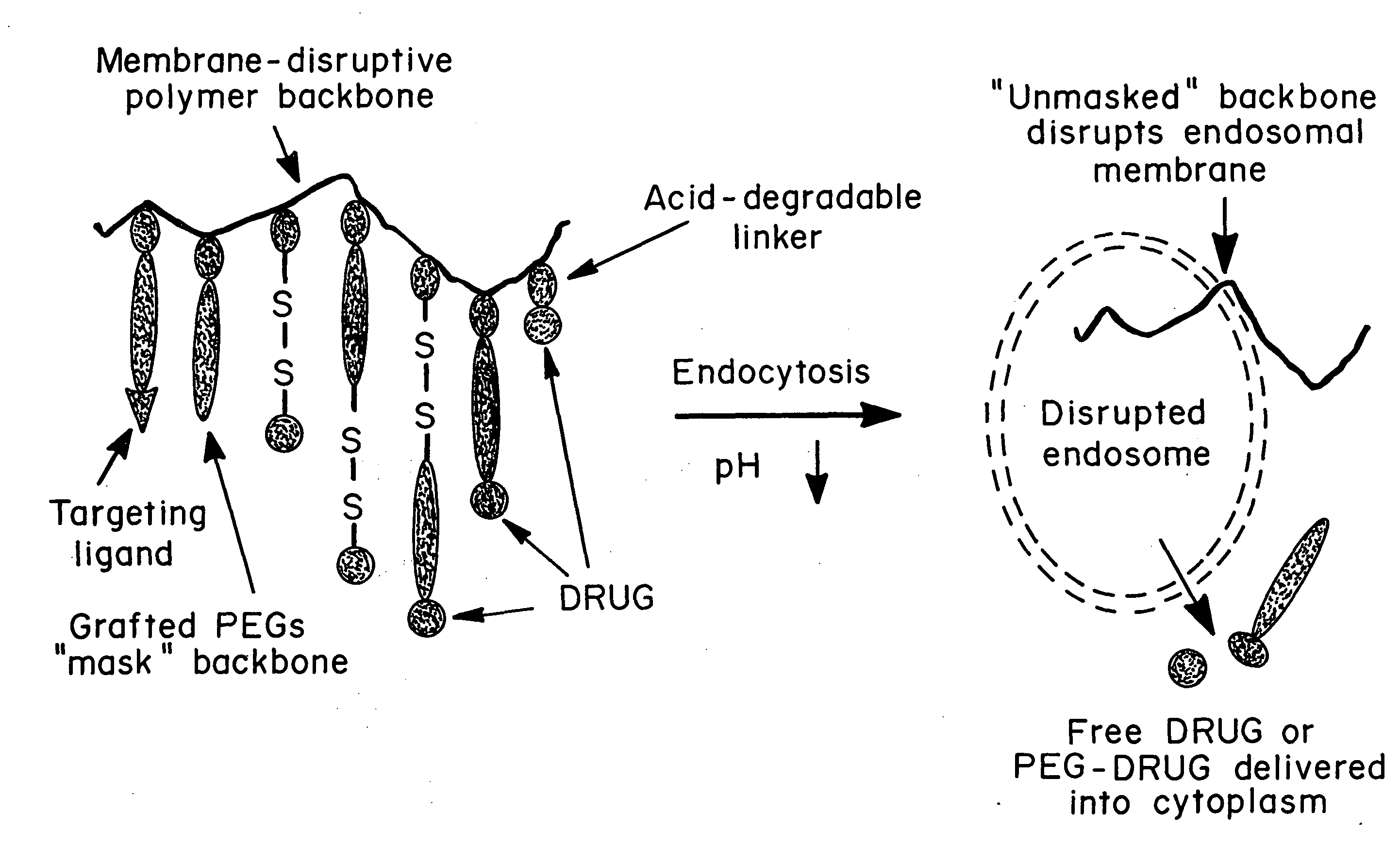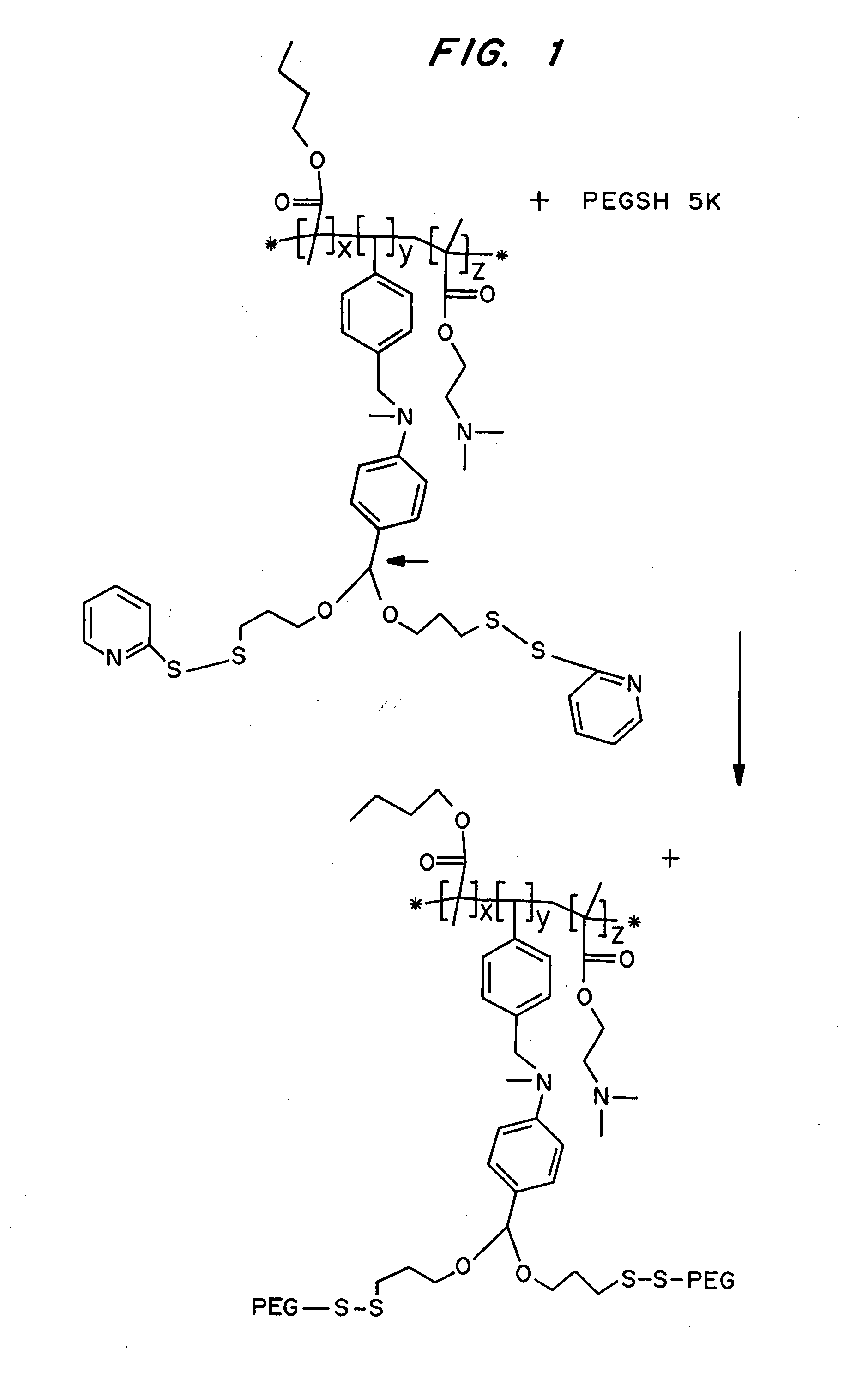Enhanced transport using membrane disruptive agents
a technology of disruptive agents and transport channels, applied in drug compositions, microcapsules, metabolic disorders, etc., can solve problems such as disrupting the endosomal or other cellular membranes, and achieve the effect of enhancing endocytosis and preventing uptake and clearance of compositions
- Summary
- Abstract
- Description
- Claims
- Application Information
AI Technical Summary
Benefits of technology
Problems solved by technology
Method used
Image
Examples
example 1
pH Mediated Disruption of Membranes using Acetal-PEG-Copolymer
[0136]This example demonstrates that an acetal-PEG-copolymer can act as an endosomal releasing agent. This was determined by measuring the hemolytic activity of the above polymers at endosomal pH (5.5) and physiologic pH (7.4).
[0137]Synthesis of the polymeric conjugate is shown in FIG. 1.
[0138]Hemolysis Assay: Fresh human blood was isolated in EDTA containing vacutainers, washed three times with 150 mM NaCl, and resuspended at a concentration of 108 red blood cells / ml in PBS buffer (2% in 1 ml PBS) at either pH 5.5 or pH 7.4. The polymer was dissolved pH 10 buffered PBS. The appropriate volume of polymer solution was then added to the RBC solution and incubated for 20 minutes at 37° C. The cells were then centrifuged and the degree of hemolysis was determined by measuring absorbance of the supernatant at 541 nM. A 100% lysis was determined by lysing the red blood cells in deionized water. The controls were RBCS suspended ...
example 2
Synthesis of Compositions Containing a Terpolymer of Dimethylaminoethyl Methacrylate, Butyl Methacrylate and Styrene Benzaldehyde for pH Mediated Disruption of Membranes
[0140]A terpolymer of dimethylaminoethyl methacrylate (DMAEMA), butyl methacrylate (BMA) and styrene benzaldehyde was chosen for the membrane-disruptive backbone (see FIG. 4). Copolymers of BMA and DMAEMA are extremely effective membrane disruptive agents, a property that can be attributed to their cationic and hydrophobic components, leading to a surfactant-like character. C. Hansch, W. R. Glave, Mol. Pharmacol, 7:337 (1972).
[0141]The strategy used to synthesize the compositions is depicted in FIG. 5. The first step was the synthesis of a functionalized acetal monomer. This monomer was then copolymerized with DMAEMA and BMA using a free radical polymerization process. The resulting terpolymer was purified by precipitation in hexane and then PEGylated with thiol-terminated monofunctional or heterobifunctional PEGs. T...
example 3
Hydrolysis and Hemolysis Studies with Polymer E1
[0142]The hydrolysis of polymer E1 was measured at 37° C., in phosphate buffer, at either pH 5.4 or 7.4, by observing the change in U.V. absorbance at 340 nm. The experiments were done in triplicate and the standard deviation was under 5% for all samples.
[0143]The ability of polymer E1 to stimulate pH-induced membrane disruption was tested by assaying its ability to disrupt red blood cell membranes (RBCs) at pH 5.0 and pH 7.4 (FIG. 6B). One-hundred million RBCs in a 1 ml volume of phosphate buffer were used in each experiment. The incubation time was 20 minutes at 37° C. The experiments were done in triplicate and the standard deviation was under 5% for all samples. The protocol used to isolate and purify the red blood cells and quantitate hemolysis is described in N. Murthy, J. R. Robichaud, D. A. Tirrell, P. S. Stayton, A. S. Hoffman, J. Contr Rel, 61:137 (1999).
[0144]Only 0.5-5 μg / ml of the polymer E1 was required for efficient hemo...
PUM
| Property | Measurement | Unit |
|---|---|---|
| pH | aaaaa | aaaaa |
| pH | aaaaa | aaaaa |
| pH | aaaaa | aaaaa |
Abstract
Description
Claims
Application Information
 Login to View More
Login to View More - R&D
- Intellectual Property
- Life Sciences
- Materials
- Tech Scout
- Unparalleled Data Quality
- Higher Quality Content
- 60% Fewer Hallucinations
Browse by: Latest US Patents, China's latest patents, Technical Efficacy Thesaurus, Application Domain, Technology Topic, Popular Technical Reports.
© 2025 PatSnap. All rights reserved.Legal|Privacy policy|Modern Slavery Act Transparency Statement|Sitemap|About US| Contact US: help@patsnap.com



